#28 May 1937
Explore tagged Tumblr posts
Text





















The Golden Gate Bridge opened to pedestrian traffic on May 27, 1937, creating a vital link between San Francisco and Marin County, California.
The Golden Gate Bridge opened to vehicular traffic on May 28, 1937.
#Golden Gate Bridge#opened#27 May 1937#28 May 1937#anniversary#US history#San Francisco#California#USA#original photography#architecture#engineering#summer 2012#travel#Crissy Field#Golden Gate National Recreation Area#Irving Morrow#Joseph Strauss#Charles Ellis#Golden Gate#Pacific Ocean#landmark#tourist attraction#Art Deco#vacation#cityscape#2022
9 notes
·
View notes
Text
Helena Bertinelli/Huntress Reading List/Completionist Guide
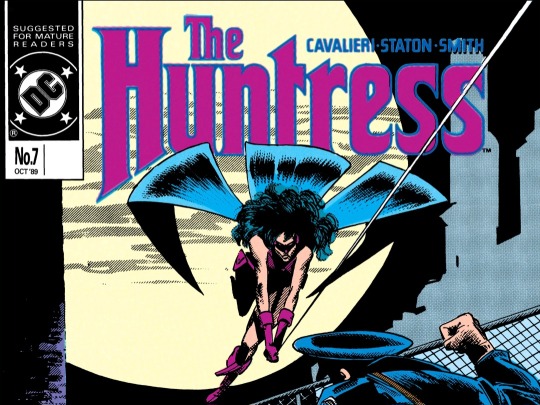
Helena Bertinelli is the Huntress of Prime Earth. She has existed as a character since 1989, and has appeared in her own series as well as multiple other series throughout the years. Most well known for being a Bird of Prey, she has a long history that tends to be hard to track. Instead of hunting down all of the issues, this guide has every one of her appearances in the attempt to follow her chronologically, but where her movements couldn’t be followed the natural passing of time was used to follow the story.
This is both a reading list and a completionist guide. This means there will be times when the issue only has a cameo of Helena. For a casual reader this list may be a little much. If that is the case click [here] for a shorter list that can get you started on Helena.
Moving onto Content Warnings.
There will be mentions and depictions of Sexual Assault of Adults and Minors, Slavery, PTSD, and Murder. These are some of the big Content Warnings. That being said let’s get started.
[Start Here]
Huntress (1989) #1, #2
Justice League America (1987-1996) #26
Huntress (1989) #3 - #6
Justice League America (1987-1996) #30, #31
Huntress (1989) #7 - #12
Justice League America (198-1996) #35
Time Masters (1990) #1
Huntress (1989) #13 - #19
Justice League International Special (1990) #1
Justice League America (1987-1996) #42
Justice League International Special (1991) #2
Armageddon (1991) #2
Detective Comics (1937-2011) #652, #653
Robin III: Cry of the Huntress #1 - #6
Justice League Europe (1989-1994) #47 - #50
Detective Comics (1937-2011) #662
Showcase ‘93 (1993) #9 , #10
Black Canary (1993) # 9 - #12
Green Arrow (1997-1998) #83
Showcase ‘94 (1994) #5
Robin (1993-2009) #6
Showcase ‘94 (1994) #6
Huntress (1994) #1 - #4
Robin (1993-2009) #17
Detective Comics (1937-2011) #686
The Batman Chronicles (1995-2000) #1
Underworld Unleashed (1995) #2 , #3
Batman (1940-2011) #529
Batman: Shadow of the Bat (1992-1999) #49
Detective Comics (1937-2011) #698
The Batman Chronicles (1995-2000) #4
Batman: Shadow of the Bat (1992-1999) #53
Batman (1940-2011) #533
Detective Comics (1937-2011) #701
Robin (1993-2009) #33 , #34
Birds of Prey: Manhunt (1996) #1 - #4
Detective Comics (1937-2011) #703
Green Lantern (1990-2004) #81
Robin (1993-2009) Annual #6 , #45
Genesis (1997) #1 - #4
Catwoman (1993-2001) #51 , #52
Spectre (1992-1998) #62
JLA (1996-2006) #16 - #19
Nightwing and Huntress (1998) #1 - #4
Batman 80-Page Giant (1998/1999) #1
Green Lantern (1990-2004) #103
Superman: Doomsday Wars (1998-1999) #1 - #3
DC One Million (1998) #1 , #2
JLA (1996-2006) #1,000,000
DC One Million (1998) #3, #4
JLA Secret Files (1997-2000) #2
JLA (1996-2006) #24 - #26
Hourman (1999-2001) #1
Nightwing (1996-2009) #26 - #29
JLA (1996-2006) #27
JLA/Titans (1998/1999) #1 - #3
Batman 80-Page Gaint (1998/1999) #2
The Batman Chronicles (1995-2000) #19
Detective Comics (1937-2011) #720
Batman: Huntress/Spoiler - Blunt Trauma (1998) #1
Detective Comics (1937-2011) #721
The Batman Chronicles (1995-2000) #14
Robin (1993-2009) #65

Batman: No Man’s Land (1999) #1
Batman: Shadow of the Bat (1992-1999) #83
Batman (1940-2011) #563
Batman: Legends of the Dark Knight (1989-2010) #116
Batman: Shadow of the Bat (1992-1999) #84
Batman (1940-2011) #564
Detective Comics (1937-2011) #731
Batman: Legends of the Dark Knight (1989-2010) #117
Batman (1940-2011) #565
Detective Comics (1937-2011) #732
Batman: Shadow of the Bat (1992-1999) #86
Detective Comics (1937-2011) #733
JLA (1996-2006) #28 - #31
Martian Manhunter (1998-2001) #6 - #9
JLA (1996-2006) #32
Martian Manhunter (1998-2001) Annual #2
Batman: Legends of the Dark Knight (1989-2010) #119
Batman: Shadow of the Bat (1992-1999) #87
Batman (1940-2011) #567
Batman: Legends of the Dark Knight (1989-2010) #120
Nightwing: Secret Files and Origins (1999) #1
Batman (1940-2011) #568
Catwoman (1993-2001) #72
Batman (1940-2011) #570
Detective Comics (1937-2011) #737
Batman: No Man’s Land - Secret Files & Origins (1999) #1
Batman: Shadow of the Bat (1992-1999) #93
The Batman Chronicles (1995-2000) #18
Nightwing (1996-2009) #38 - #39
Batman: No Man’s Land (1999) #0
Batman (1940-2011) #573
Detective Comics (1937-2011) #740
Batman: Legends of the Dark Knight (1989-2010) #126
Batman (1940-2011) #574
Detective Comics (1937-2011) #741
Batman: Shadow of the Bat (1992-1999) #94
Batman: Gotham Knights (2000-2006) #1
Batman: Gotham City Secret Files and Origins (2000) #1
JLA: Foreign Bodies (1999) #1
JLA (1996-2006) #34 - #41
JLA: Secret Files and Origins (1997-2000) #3
Azrael: Agent of the Bat (1994-2203) #63 - #65
Stars and S.T.R.I.P.E (1999/2000) #8
The Batman Chronicles (1995-2000) #15
Batman: Gotham Knights (2000-2006) #7
Batman/Huntress: Cry For Blood #1 - #6
Batman: Outlaws (2000) #1 - #3
Nightwing (1996-2009) #52
Wonderwoman (1987-2006) #164 - #167
Justice League: Justice League of Amazons (2001) #1
Justice League: JL? (2001) #1
Superman: The Man of Steel (1991-2003) #109
Batman (1940-2011) #586
Batgirl (2000-2006) #18
Batman (1940-2011) #591
JLA (1996-2006) #58
Detective Comics (1937-2011) #763
Joker: Last Laugh (2001) #5
Robin (1993-2009) #95
Joker: Last Laugh (2001) #6
JLA: Incarnations (2001-2002) #7
Detective Comics (1937-2011) #773
Batman: Gotham Knights (2000-2006) #34, #35
Nightwing (1996-2009) #75
JLA: Welcome to the Working Week (2003) #1
Batman: Family (2002-2003) #2, #4, #8
Batman (1940-2011) #609
Batman: Gotham Knights (2000-2006) #37 - #40
Action Comics (1938-2011) #802
Batman (1940-2011) #617 , #619
Bird of Prey: Secret Files and Origins (2003) #1
Birds of Prey (1998-2009) #57 - #61
Robin (1993-2009) #120
Batman: Gotham Knights (2000-2006) #48
Superman/Batman (2003-2011) #5
Outsiders (2003-2007) #8 - #10
The Adventures of Superman (1987-2004) #623
Gotham Central (2002-2006) #17 , #18
Batman: Gotham Knights (2000-2006) #50
Birds of Prey (1998-2009) #64 - #66
Outsiders (2003-2007) #12
Birds of Prey (1998-2009) #67 - #80
Teen Titans (2003-2011) #21
Birds of Prey (1998-2009) #81, #82
The OMAC Project (2005) #2
Birds of Prey (1998-2009) #83 , #84
Detective Comics (1937-2011) #809
JLA (2005-2008) #117, #119
Birds of Prey (1998-2009) #85 - #87
Nightwing (1996-2009) #112
Birds of Prey (1998-2009) #86
JSA: Classified (2005-2008) #3
JLA (2005-2008) #121
Birds of Prey (1998-2009) #88 - #91
Infinite Crisis (2005-2006) #5 , #7
Adventures of Superman (1987-2006) #648
Villains United: Infinite Crisis Special (2006) #1
52 (2006-2007) #1
Robin (1993-2009) #148
Birds of Prey (1998-2009) #92 - #99
Nightwing (1996-2009) #127
52 (2006-2007) #34
Birds of Prey (1998-2009) #100 - #103
52 (2006-2007) #48 , #52
Birds of Prey (1998-2009) #104 - #108
Justice League of America Wedding Special (2007) #1
Green Arrow / Black Canary Wedding Special (2007) #1
Birds of Prey (1998-2009) #110
Green Arrow and Black Canary (2007-2010) #1
Detective Comics (19337-2011) #837
Gotham Underground (2007/2008) #2 , #7
Birds of Prey (1998-2009) #111 - #115
Countdown to Mystery (2007/2008) #6 , #8, #9
Birds of Prey (1998-2009) #116
Birds of Prey (1998-2009) #117 - #119
Huntress: Year One (2008) #1 - #6
Manhunter (2004-2009) #33 - #36
Trinity (2008-2009) #9, #13 , #14 , #50
Final Crisis: Requiem (2008) #1
Final Crisis (2008/2009) #3
Birds of Prey (1998-2009) #120 - #123
DC Universe: Decisions (2008) #3
Secret Six (2008-2011) #1 , #7
Batman and the Outsiders (2007-2011) #13
Birds of Prey (1998-2009) #124 - #127
Batman and the Outsiders (2008/2009) #4 , #5
Batman: Battle for the Cowl (2009) #1 , #2
Batman: Battle for the Cowl: Network (2009) #1
Batman: Battle for the Cowl (2009) #3
Batman: Streets of Gotham (2000-2011) #3 - #6 , #9, #13
Blackest Night: Batman (2009) #2
Batman (1940-2011) #693 - #695 , #697
Azrael (2009-2011) #2
Detective Comics (1937-2011) #859 - #663
Justice Society of America (2007-2011) #38
Detective Comics (1937-2011) #864, #865
Red Robin (2009-2011) #12
Batgirl (2009-2011) #10 , 11
Birds of Prey (2010-2011) #1 - #4
Batman: The Return of Bruce Wayne (2010) #3
Birds of Prey (2010-2011) #5 , #6
Superman/Batman (2003-2011) #78
Birds of Prey (2010-2011) #7 - #10
Brightest Day (2010-2011)
Birds of Prey (2010-2011) #11
Batman Incorporated (2011) #6
Secret Six (2008-2011) #36
Birds of Prey (2010-2011) #12 - #15
Batman (1940-2011) #713
Convergence: The Question (2015) #1, #2

New - 52
Batwoman (2011-2015) #2
Secret Origins (2014-2015) #8
Nightwing (2011-2014) #30
Grayson (2014-2016) #1 - #5 ,Annual #1 , #6 - #11
Batgirl (2011-2016) Annual #3
Midnighter (2015) #3
Harley Quinn (2014-2016) #20
Grayson (2014-2016) Annual #2
Batman & Robin Eternal (2015/2016) #2 , #3
Titans Hunt (2015-2016) #1
Grayson (2014-2016) #13 , #14
Batman & Robin Eternal (2015/2016) #5
Midnighter (2015) #8
Batman & Robin Eternal (2015/2016) #17
Grayson (2014-2016) #16
Midnighter (2015) #9
Batman & Robin Eternal (20115/2016) #18 - #20
Grayson (2014-2016) #17
Midnighter (2015) #10
Batman & Robin Eternal (20115/2016) #23 , #24
Grayson (2014-2016) #18
Batman & Robin Eternal (20115/2016) #25
Midnighter (2015) #11
Grayson (2014-2016) #19
Midnighter (2015) #12
Grayson (2014-2016) #20 Annual #3

Rebirth
DC Universe: Rebirth (2016) #1
Nightwing: Rebirth (2016) #1
Batgirl and the Birds of Prey: Rebirth (2016) #1
Batgirl and the Birds of Prey (2016-2018) #1 - #4
Nightwing (2016-) #9
Batgirl and the Birds of Prey (2016-2018) #5 - #13
Nightwing (2016-) #26 - #28
Batgirl and the Birds of Prey (2016-2018) #14
Nightwing (2016-) #30 , #31
Batgirl and the Birds of Prey (2016-2018) #15 - #22
The Hellblazer (2016-2018) #19 - #24
The Unexpected (2018-2019) #3 , #4
Green Arrow (2016-2019) #45
Aquaman/Justice League: Drowned Earth (2018) #1
Detective Comics (2016-) #1000
Batman (2016-) #71
Action Comics (1938-) #1011
Harley Quinn (2016-2020) #64
Batgirl (2016-2020) #39
DC Villains Giant (2019) #1
Batman (2016-) #81 - #83
Birds of Prey: Sirens of Justice (2020) #1
Birds of Prey (2020-) #1
Batgirl (2016-2020) #50
Dark Knights: Death Metal (2020) #5
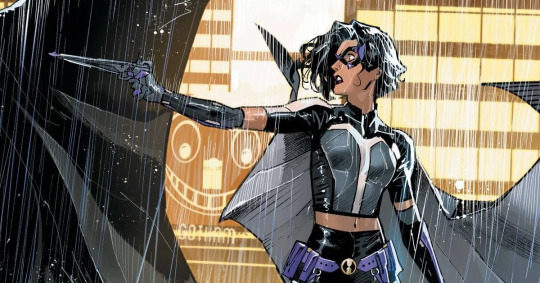
Infinite Frontier
Infinite Frontier #0
Detective Comics (2016-) #1034 - #1039
The Other History of the Dc universe (2021) #5
Batman Secret Files; Huntress (2021) #1
Detective Comics (2016-) #1041 , #1042 , #1046
Robins (2021-2022) #4, #5
Detective Comics (2016-) #1047. #1049 - #1058 , #1061
Nightwing (2016-) #95
Batman: Dear Detective #1
Dark Crisis on Infinite Earths (2022) #5
Batman (2016) #129
Nightwing (2016-) #98
Lazarus Planet: Dark Fate (2023) #1
[Current Present: July 2023]

Else Worlds and Others
Harley Quinn and the Birds of Prey (2020) #1 - #4
Superman and Batman: World’s Funniest (2000) #1
JLA: Act of God (2000-2001) #1
Future State:
Future State: Dark Detective (2021) #1 , #3
Future State: Nightwing (2021) #1 , #2
DCeased:
DCeaased (2019) #3, #4
DCeased: Unkillable: #1
DC vs. Vampires:
DC vs. Vampires (2021-2023) #2 , #10 , #11
DCAU:
Superman & Batman Magazine (1993-1995) #1 , #4
The Batman & Robin Adventures (1995-1997) #19
Justice League Unlimited (2004-2008) #20 , #22 , #27 , #31 , #36
Batman: The Adventures Continue Season Two (2021-2022) #3
Injustice:
Injustice: Year Zero (2020-2021) Chapter #1 , #2
Injustice: Gods Among Us (2013-2016) #6 , #7 , #9 , #11 , 12
Injustice: Gods Among Us - Year Two (2013-2016) #3 , #6 , #7 - #11 , Annual #1
Injustice: Gods Among us - Year Three (2013-2016) #2 , #6 , #9 - #12
Injustice: Gods Among Us - Year Four (2013-2016) #1
Flashpoint:
Flashpoint: Emperor Aquaman (2011) #2 , #3
Flashpoint: Wonder Woman and the Furies (2011) #2 , #3
Flashpoint: Lois Lane and the Resistance (2011) #2
Convergence (2015) #6 , #7
Tiny Titans:
Tiny Titans (2008-2012) #45
Bombshells:
DC Comics: Bombshells (2015-2017) #6 , #10 , #16 , #17 , #18 , #26
Bombshells: United (2017-2018) #36
Batman: The Brave and The Bold:
Batman: The Brave and The Bold (2009-2010) #11 , #14
All-New Batman: The Brave and The Bold (2011-202) #4
Lil’Gotham:
Batman: Lil’Gotham (2013-2014) #3 , #5 , #6 , #8 , #10 , #12
Scooby-Doo:
Scooby-Doo Team-Up (2018) #34
The Batman & Scooby-Doo Mysteries (2021-) #5 , #12

Other Appearances (Crossovers)
Batman Versus Predator II (1993/1994) # 1 - #4
JLA/Witchblade (2000-2001) #1
Avengers/JLA (2003/2004) #4
Other Characters to hold the name, Huntress:
Paula Brooks
Helena Wayne
Carol Danvers (Amalgamverse)
Charlotte Gage-Radcliffe
>~<>~<>~<>~<
To the Helena Bertinelli fans I hope you enjoy!
@inkareds I finished the complete guide if you want to check it out.
If I made any mistakes or forgot something leave a comment, or send me a message. I tried to include everything, but I could have messed up. I will also try to update this as new Huntress stuff comes out, so the list may grow.
#reading guides#reading order#comic guide#character reading list#comic reading list#helena bertinelli#Huntress#dc huntress#DC comics#dc reading list#helena my love
417 notes
·
View notes
Photo

Thermidorian Reaction
The Thermidorian Reaction refers to the period of the French Revolution (1789-1799) between the fall of Maximilien Robespierre on 27-28 July 1794 and the establishment of the French Directory on 2 November 1795. The Thermidorians abandoned radical Jacobin policies in favor of conservative ones, seeking the restoration of a stable constitutional government and economic liberalism.
The Thermidorians came to power by conspiring against and overthrowing Maximilien Robespierre (1758-1794). After his execution, the Thermidorian regime set about dismantling the Reign of Terror by purging the Jacobins from positions of power and by violently suppressing their ideology in the First White Terror. Their efforts to return stability to France resulted in pursuance of conservative policies reminiscent of earlier phases of the Revolution; they restored freedom of religion, reintroduced free market capitalism, and allowed the return of some aristocratic émigrés into France, leading to a rise in openly royalist sentiment. These policies were met with mixed success.
The new regime was generally unpopular with the French people, who faced increased rates of poverty and starvation during the 15 months of Thermidorian rule. This led to multiple attempted coups, the most significant of which was the Uprising of 1 Prairial Year III (20 May 1795), in which insurgents demanded bread and the adoption of the dormant constitution of 1793, which had been written by the Jacobins. After the uprising had petered out, the Thermidorians wrote their own constitution of Year III (1795), which established the French National Directory.
Thermidorians
The name 'Thermidorians', ascribed to the conspirators against the Robespierrist regime, is derived from the mid-summer month of Thermidor in the French Republican calendar, during which the coup took place. Though possessing a shared distaste for Robespierre, the Thermidorians had little else in common. Some of them had been willing and enthusiastic participants of the Terror before they had run afoul of Robespierre and needed to be rid of him to save their own skins. Others had detested the Terror from the start and had been eager to bring it down. Many were conservative republicans who represented the centrist mass of Convention deputies known as the 'Plain', who desired to turn back the clock to the way the Revolution had been in 1792, pre-Terror; others wished to go back further, seeking a second attempt at constitutional monarchy, as in 1791.
This lack of consensus, as well as the absence of dominating personalities to rally behind, contributed to the ineffectiveness and unpopularity of the Thermidorian Convention. The lackluster success of their policies has certainly marred the Thermidorians' legacy. Their detractors viewed them as an unremarkable interlude between Robespierre and Napoleon at best; at worst, they were the gravediggers of their own Revolution, one-time revolutionaries seduced and corrupted by the heights of power. This latter context was used by Leon Trotsky in his 1937 book The Revolution Betrayed, in which he refers to the rise of Joseph Stalin as a Soviet Thermidor.
While there may be elements of truth to these claims, historian Bronisław Baczko asserts that the Thermidorians were merely being realistic. The Revolution, having lost much of its momentum, grew closer to succumbing to fatigue with every month. It was becoming clearer that the Revolution could no longer live up to the promises made in 1789. Therefore, rather than willfully burying the Revolution, Baczko argues that the Thermidorians realized these limitations and simply did their best to work around them. After the violence of the Terror, many French people desired stability over revolutionary progress, which the Thermidorians attempted to give them. In either case, the period of the Thermidorian Reaction marked a counter-revolution of sorts, moving away from the radical progress of the Jacobins and back toward stable conservatism.
Continue reading...
23 notes
·
View notes
Text

The mummified remains of King Thutmose IV (Menkheperure)
New Kingdom, 18th Dynasty The king is now at rest in the National Museum of Egyptian Civilization.
The mummy of Thutmose IV was found within the mummy cache of KV35 in 1898 by Victor Loret. The body of the king was moved in antiquity by ancient priests for safety reasons. The king was originally buried within his own tomb (KV43), which was discovered by Howard Carter in 1903.
Grafton Elliot Smith (1871-1937), upon examining the body of the king, concluded that the king was very ill at the time of death and had seemingly suffered with an illness for a while, sadly describing Thutmose IV as "extremely emaciated".
Many decades later in 2012, the Imperial College London examined the body of the late king, and along with knowledge of some of Thutmose's family dying young (such as his great-grandson Tutankhamun and his two still born daughters), the surgeon examining the king theorized that Thutmose and other members of the family may have possibly suffered with Temporal lobe epilepsy.
Some scholars think that this idea could explain the king's famous Dream Stela, where he describes the Sphinx of Giza as talking to him, as those with Temporal lobe epilepsy do suffer with visions. This idea however is a theory at the present and is not an ultimate conclusion. And it must be noted that the reason for the dream stela could have been propagandist, or simply Thutmose certifying his status as a divine ruler...such as Hatshepsut's writing of her divine birth at Deir el-Bahari. Or... it could have been something the king truly believed occurred to him, without the modern idea that he had an illness causing such a thing.
The king's body measures at 1.64m (5 ft 4.8 in), however, due to his disembodied feet, he was likely taller in life. He was relatively young, with Smith putting his age at death at approximately 28, although more modern scholars suggest mid 30s, perhaps. He has both ears pierced and what appears to be a smile with teeth showing. Most notable is his hair, which is entirely natural, long and parted in the middle, the colour is reddish brown.
Read more
65 notes
·
View notes
Text
Notable Deaths in 2023 . . .

Tom Smothers (February 2, 1937-December 26, 2023)

Ryan O'Neal (April 20, 1941-December 8, 2023)

Legendary TV producer Norman Lear (July 27, 1922-December 5, 2023)
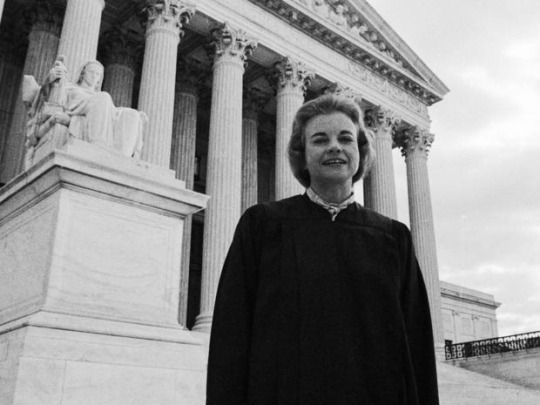
Sandra Day O'Connor (March 26, 1930-December 1, 2023)

Former first lady Rosalynn Carter (August 18, 1927-November 19, 2023)
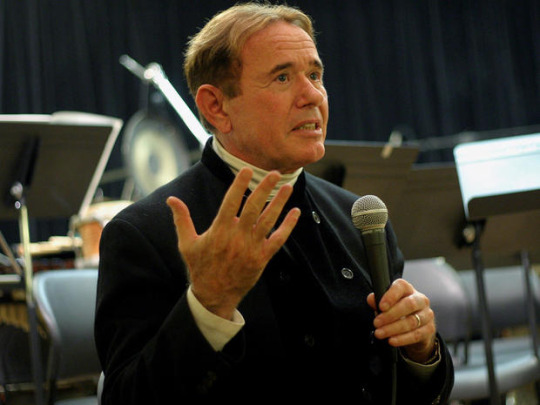
Pulitzer Prize-winning composer David Del Tredici (March 16, 1937-November 18, 2023)

A U.S. Air Force fighter pilot and instructor at West Point, astronaut Frank Borman (March 14, 1928-November 7, 2023)

College basketball coach Bob Knight (October 25, 1940-November 1, 2023)

As Chandler Bing, a quick-witted, sarcastic member of the coterie of "Friends," Matthew Perry (August 19, 1969-October 28, 2023)
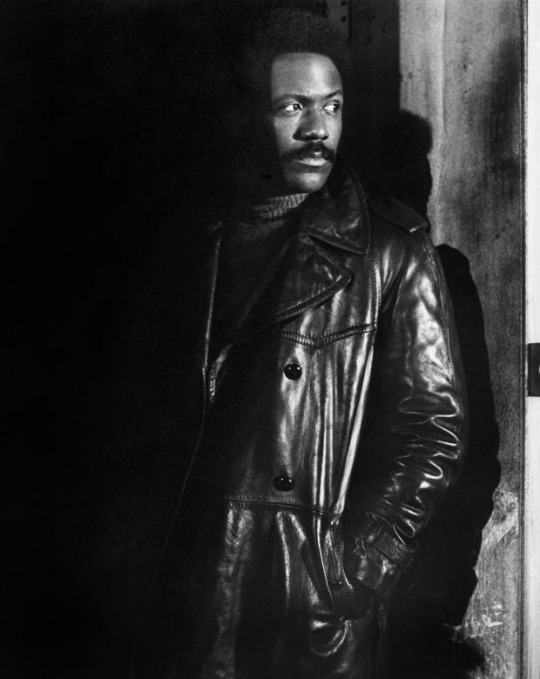
As the star of the trailblazing 1971 action movie "Shaft," Richard Roundtree (July 9, 1942-October 24, 2023)
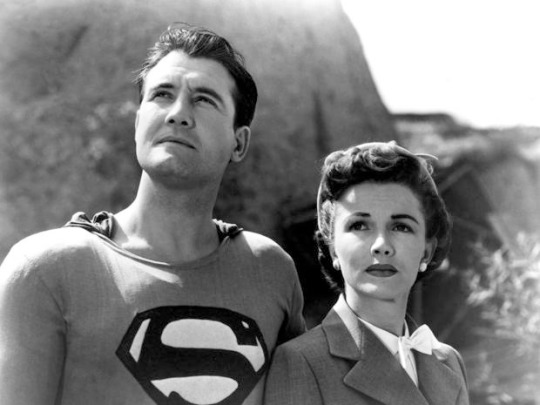
Actress Phyllis Coates (January 15, 1927-October 11, 2023) "Adventures of Superman."

Character actor Burt Young (April 30, 1940-October 8, 2023)

Irish-English actor Sir Michael Gambon (October 19, 1940-September 27, 2023)
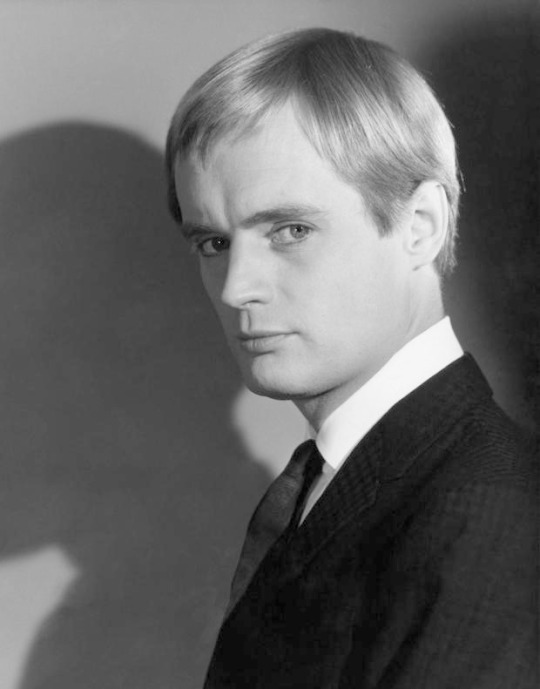
Actor David McCallum (September 19, 1933-September 25, 2023)

The songs of Jimmy Buffett (December 25, 1946-September 1, 2023)

Singer Tina Turner (November 26, 1939-May 24, 2023)

Canadian singer-songwriter Gordon Lightfoot (November 17, 1938-May 1, 2023)
. . . And MANY More...I just couldn't post ALL of them.
NOTHING Last Forever...! (Remember That)
29 notes
·
View notes
Text


San Francisco’s Golden Gate Bridge opened to the public for “Pedestrian Day”on March 27, 1937. #OnThisDay The next day, on May 28, the Golden Gate Bridge opened to vehicular traffic.
86 notes
·
View notes
Text


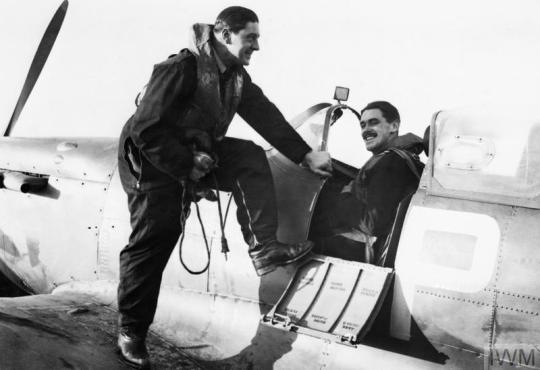
Harbourne Mackay Stephen was born in Elgin on 18th April 1914.
Harbourne was the son of a bank manager. He was initially educated privately, but then went to schools in Edinburgh and later at Shrewsbury School in Shropshire. He finished his schooling when he was 15-years-old and soon afterwards shifted to London to work in the newspaper industry. His first job was copy boy with Allied Newspapers and later he moved to the advertisement staff of the Evening Standard.
Stephen joined the Royal Air Force Volunteer Reserve in April 1937 as an and learned to fly. Having achieved the required standard and number of flying hours, Stephen was offered the chance to train with the regular RAF for six months and was given six months leave of absence from his job.
He was offered a full Commission in April 1940 Stephen was posted to 74 Squadron at Hornchurch Over Dunkirk on 24th May he shared in destroying several German aircraft.
Pilot Officer Stephen shot down his first German plane on July 28 1940, and in the next 14 days he shot down 11 more. His score of eight victories in one day came on August 11th when he destroyed three Me109s and two Me110s, probably destroying another and damaging two more. He was awarded the Distinguished Flying Cross.
Flying Spitfires with 605 squadron he took part in the air battles over France and Dunkirk and throughout the thick of the Battle of Britain. He was one of the top scoring R.A.F. pilots at the end of 1940 with 22 and a half air victories
Harbourne Mackay Stephen was the first airman to be awarded a DSO, )Distinguished Service Order)in the field As one of the ''Tigers'' (74 Squadron) he shared the honour of shooting down the 600th aircraft to be destroyed by fighters from a single RAF. After the Battle of Britain, Stephen was posted to Turnhouse , Edinburgh as Chief Flying Instructor; but this was not his idea of active service, and he soon volunteered to go to the Far East in 1942 where he took command of 166 wing, remaining in fighters until the end of the war.
After the war he had a successful career in newspapers where he became managing Director of the Daily Telegraph and Sunday Telegraph. He died on 20th August 2001.
10 notes
·
View notes
Text
Coronation Timings
Queen Victoria
Ascended the throne: 20 June 1837.
Coronation: 28 June 1838.
Crowned 12 months after her ascension to the throne.
Edward VII
Ascended the throne: 22 January 1901.
Coronation: 9 August 1902, planned for 26 June 1902 but deferred because the King had appendicitis.
Crowned 19 months after his ascension to the throne. The coronation was originally planned for 17 months after ascension.
George V
Ascended the throne: 6 May 1910.
Coronation: 22 June 1911.
Crowned 13 months after his ascension to the throne.
Edward VIII
Ascended the throne: 20 January 1936.
Coronation: Never happened; he abdicated on 11 December 1936.
George VI
Ascended the throne: 11 December 1936.
Coronation: 12 May 1937.
Crowned 5 months after his ascension; the coronation was planned for his brother Edward VIII and was held 16 months after the death of George V.
Elizabeth II
Ascended the throne: 6 February 1952
Coronation: 2 June 1953
Crowned 16 months after her ascension to the throne.
Charles III
Ascended the throne: 8 September 2022.
Coronation: 6 May 2023.
Crowned 8 months after his ascension to the throne.
He just can't wait to be king crowned.
101 notes
·
View notes
Text
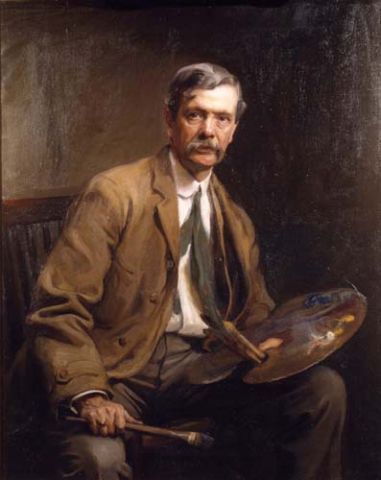
Philip de László - Portrait of Portrait of Sir Alfred East - 1907
Philip Alexius László de Lombos MVO RBA (born Fülöp Laub; Hungarian: Fülöp Elek László; 30 April 1869 – 22 November 1937), known professionally as Philip de László, was an Anglo-Hungarian painter known particularly for his portraits of royal and aristocratic personages. In 1900, he married the Anglo-Irish socialite Lucy Guinness, and he became a British subject in 1914. László's patrons awarded him numerous honours and medals. He was invested with the Royal Victorian Order by Edward VII in 1909 and, in 1912, he was ennobled by Franz Joseph I of Austria; becoming a part of the Hungarian nobility.
Sir Alfred Edward East RA RBA (15 December 1844 – 28 September 1913) was an English painter.
Alfred East was born in Kettering in Northamptonshire and studied at the Glasgow School of Art. His romantic landscapes show the influence of the Barbizon school. His The Art of Landscape Painting in Oil Colour was published in 1906. In April 1888 he had shared an exhibition at the galleries of the Fine Art Society with T.C. Gotch and W. Ayerst Ingram, and was commissioned the following year by Marcus Huish, managing director of the Society, to spend six months in Japan to paint the landscape and the people of the country. When the exhibition of 104 paintings from this tour was held at the Fine Art Society in 1890 it was a spectacular success.
East visited Spain after 1892 when he visited Algeciras at the southern end of Iberia.
In 1906 he was elected president of the Royal Society of British Artists, a position he held until his death. In that year, he published his 107-page illustrated "The Art of Landscape Painting in Oil Colour"; in its preface, he made the observation: "The greatest errors in landscape painting are to be found – contradictory as it may appear – not so much in the matter of technique as in the painter's attitude toward Nature". In this book he described his techniques using colours, half-tones and pencil sketches.
He was awarded a Knighthood in 1910 by King Edward VII. His portrait was painted by Philip de Laszlo. The Alfred East Art Gallery in Kettering, designed by John Alfred Gotch opened on 31 July 1913. The Alfred East Gallery is Northamptonshire's oldest purpose-built art gallery.
East was elected an Associate of the Royal Academy in 1899, having been a regular exhibitor since 1883 and elected to full membership in 1913.
On 28 September 1913, Alfred East died at his London residence in Belsize Park. His body was taken back to Kettering and lay in state in the Art Gallery, where it was surrounded by the pictures he had presented to the town, and attracted crowds of several thousands.
32 notes
·
View notes
Text

Footnotes - Part 2
[80] Graham Kemp and Douglas P. Fry (eds.), Keeping the Peace: Conflict Resolution and Peaceful Societies around the World, New York: Routledge, 2004, p. 163.
[81] All quotes and statistics on the Navajo come from Dennis Sullivan and Larry Tifft, Restorative Justice: Healing the Foundations of Our Everyday Lives, Monsey, NY: Willow Tree Press, 2001, pp. 53–59.
[82] www.harmfreezone.org (viewed November 24, 2006)
[83] Philly’s Pissed, www.phillyspissed.net [Viewed May 20, 2008]
[84] George R. Edison, MD, “The Drug Laws: Are They Effective and Safe?” The Journal of the American Medial Association. Vol. 239 No.24, June 16, 1978. A.W. MacLeod, Recidivism: a Deficiency Disease, Philadelphia: University of Pennsylvania Press, 1965.
[85] Jamie Bissonette, When the Prisoners Ran Walpole: A True Story in the Movement for Prison Abolition, Cambridge: South End Press, 2008, p. 201. Also consider the stories of John Boone and other bureaucrats presented in this story.
[86] Some mainstream sources still contest that the Makhnovists were behind anti-Semitic pogroms in Ukraine. In Nestor Makhno, Anarchy’s Cossack, Alexandre Skirda traces this claim to its roots in anti-Makhno propaganda, while citing unfriendly contemporary sources who acknowledged that the Makhnovists were the only military units not carrying out pogroms. He also references propaganda put out by the Makhnovists attacking anti-Semitism as a tool of the aristocracy, Jewish militias that fought among the Makhnovists, and actions against pogromists personally carried out by Makhno.
[87] Paul Avrich, The Russian Anarchists, Oakland: AK Press, 2005, p. 218.
[88] Makhno hoped that Lenin and Trotsky were motivated by a personal vendetta against him rather than an absolute desire to crush the free soviets, and would call off the repression if he left.
[89] Alexandre Skirda, Nestor Makhno, Anarchy’s Cossack: The Struggle for Free Soviets in the Ukraine 1917–1921, London: AK Press, 2005, p. 314.
[90] Amy Goodman, “Lakota Indians Declare Sovereignty from US Government,” Democracy Now!, December 26, 2007.
[91] From an anonymous illustrated pamphlet, “The ‘Oka Crisis’ ”
[92] Oscar Olivera, Cochabamba! Water War in Bolivia, Cambridge: South End Press, 2004.
[93] George Katsiaficas, The Subversion of Politics: European Autonomous Social Movements and the Decolonization of Everyday Life. Oakland: AK Press, 2006, p. 123
[94] Jaime Semprun, Apología por la Insurrección Argelina, Bilbao: Muturreko Burutazioak, 2002, p.34 (translated from French to Spanish by Javier Rodriguez Hidalgo; the translation to English is my own). The quotes in the next paragraphs are from p.18 and p.20.
[95] Jaime Semprun, Apología por la Insurrección Argelina, Bilbao: Muturreko Burutazioak, 2002, pp.73–74 (translated from French to Spanish by Javier Rodriguez Hidalgo; the translation to English is my own).
[96] Ditto, p.80 . Regarding the fourth point, in contrast to Western society and its various forms of pacifism, the peacefulness of the movement in Algeria does not preclude self-defense or even armed uprising, as evidenced by the preceding point regarding the martyrs. Rather, peacefulness indicates a preference for peaceful and consensual outcomes over coercion and arbitrary authority.
[97] Ditto, p.26.
[98] George Orwell, Homage to Catalonia, London: Martin Secker & Warburg Ltd., 1938, pp.26–28.
[99] There were 40,000 armed anarchist militants in Barcelona and the surrounding region alone. The Catalan government would have been effectively abolished had the CNT simply ignored it, rather than entering into negotiations. Stuart Christie, We, the Anarchists! A study of the Iberian Anarchist Federation (FAI) 1927–1937, Hastings, UK: The Meltzer Press, 2000, p. 106.
[100] Ditto, p. 101
[101] John Jordan and Jennifer Whitney, Que Se Vayan Todos: Argentina’s Popular Rebellion, Montreal: Kersplebedeb, 2003, p. 56.
[102] Natasha Gordon and Paul Chatterton, Taking Back Control: A Journey through Argentina’s Popular Uprising, Leeds (UK): University of Leeds, 2004.
[103] John Jordan and Jennifer Whitney, Que Se Vayan Todos: Argentina’s Popular Rebellion, Montreal: Kersplebedeb, 2003, p. 9.
[104] George Katsiaficas, “Comparing the Paris Commune and the Kwangju Uprising,” www.eroseffect.com. That the resistance was “well-organized” comes from a report from the conservative Heritage Foundation, Daryl M. Plunk’s “South Korea’s Kwangju Incident Revisited,” The Heritage Foundation, No. 35, September 16, 1985.
[105] Goods produced in environmentally friendly ways, by workers who receive a living wage in healthier labor conditions.
[106] Sam Dolgoff, The Anarchist Collectives, New York: Free Life Editions, 1974, p. 71.
[107] David Graeber, Fragments of an Anarchist Anthropology, Chicago: Prickly Paradigm Press, 2004, pp. 54–55.
[108] John Jordan and Jennifer Whitney, Que Se Vayan Todos: Argentina’s Popular Rebellion, Montreal: Kersplebedeb, 2003, pp. 42–52.
[109] Ditto, pp. 43–44.
[110] Diana Denham and C.A.S.A. Collective (eds.), Teaching Rebellion: Stories from the Grassroots Mobilization in Oaxaca, Oakland: PM Press, 2008, interview with Yescka.
[111] Ditto, interview with Leyla.
[112] “Longo Maï,” Buiten de Orde, Summer 2008, p.38. My own translation.
[113] Natasha Gordon and Paul Chatterton, Taking Back Control: A Journey through Argentina’s Popular Uprising, Leeds (UK): University of Leeds, 2004.
[114] For those who cannot read French or Spanish, in 2004 Firestarter Press put out a good zine about this insurrection, called “You Cannot Kill Us, We Are Already Dead.” Algeria’s Ongoing Popular Uprising.
[115] Paul Avrich, The Russian Anarchists, Oakland: AK Press, p. 212–213.
[116] Harold Barclay, People Without Government: An Anthropology of Anarchy, London: Kahn and Averill, 1982, p. 57.
[117] “Pirate Utopias,” Do or Die, No. 8, 1999, pp. 63–78.
[118] To name just one example, “humanitarian” UN missions have been caught repeatedly setting up sex trafficking rings in the countries where they are stationed for peacekeeping. “But the problem goes beyond Kosovo and sex trafficking. Wherever the UN has established operations in recent years, various violations of women seem to follow.” Michael J. Jordan, “Sex Charges haunt UN forces,” Christian Science Monitor, 26 November 2004. What the mainstream press cannot go so far as to admit is that this reality is universal to militaries, whether they wear blue helmets or not.
[119] “About RAWA,” www.rawa.org Viewed June 22, 2007
[120] See the citation of van der Dennen and Rappaport in Chapter 1.
[121] Harold Barclay, People Without Government: An Anthropology of Anarchy, London: Kahn and Averill, 1982, p. 122.
[122] Haudennosaunne oral traditions always maintained this early date, but racist white anthropologists discounted this claim and estimated the league began in the 1500s. Some even hypothesized that the Five Nations constitution was written with European help. But recent archaeological evidence and the record of a coinciding solar eclipse backed up the oral histories, proving that the federation was their own invention. Wikipedia, “The Iroquois League,” http: //en.wikipedia.org/wiki/Iroquois_League Viewed 22 June 2007
[123] Stephen Arthur, “Where License Reigns With All Impunity:” An Anarchist Study of the Rotinonshón:ni Polity,” Northeastern Anarchist No. 12, Winter 2007 nefac.net
[124] See, for example, Dmitri M. Bondarenko and Andrey V. Korotayev, Civilizational Models of Politogenesis, Moscow: Russian Academy of Sciences, 2000.
[125] The argument that certain societies were able to take over the world because of geographic conditions rather than any inherent superiority is skillfully presented by Jared Diamond in Guns, Germs, and Steel: The Fates of Human Societies. New York: W.W. Norton, 1997.
8 notes
·
View notes
Text

Passages - Alice
Linda Lavin (October 15, 1937 – December 29, 2024)
Vic Tayback (January 6, 1930 – May 25, 1990)
Beth Howland (May 28, 1941 – December 31, 2015)
Philip McKeon (November 11, 1964 – December 10, 2019)
Charles Levin (March 12, 1949 – c. June 28, 2019)
Dave Madden (December 17, 1931 – January 16, 2014)
Marvin Kaplan (January 24, 1927 – August 25, 2016)
Martha Raye (August 27, 1916 – October 19, 1994)
4 notes
·
View notes
Photo


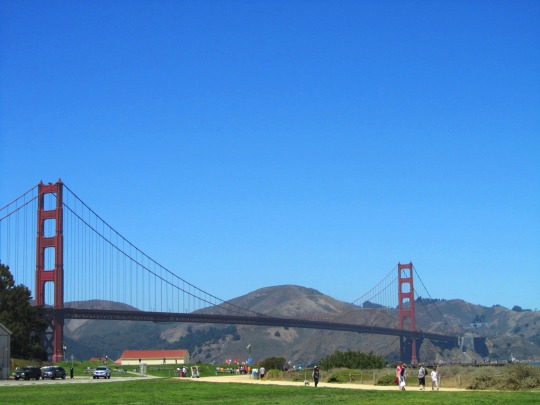

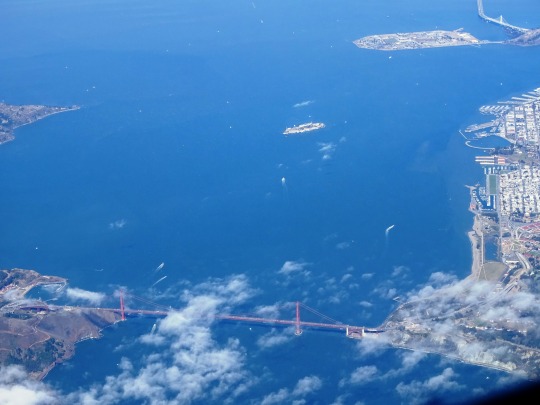





The Golden Gate Bridge opened to vehicular traffic on May 28, 1937.
#Golden Gate Bridge#opened to vehicular traffic#28 May 1937#US history#2022#summer 2012#Art Deco#Joseph Strauss#Leon Solomon Moisseiff#Golden Gate National Recreation Area#San Francisco#San Francisco Bay#California#Pacific Ocean#architecture#original photography#landmark#tourist attraction#Irving Morrow#Charles Ellis#Crissy Field#cityscape#West Coast#engineering
3 notes
·
View notes
Text
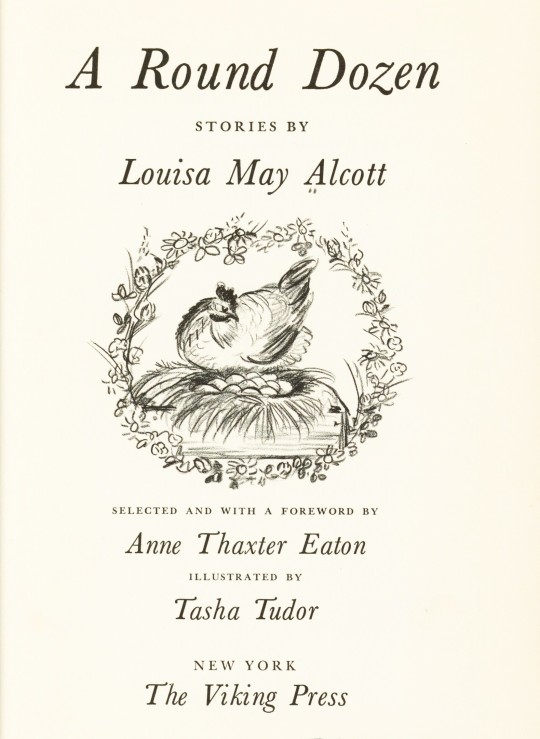
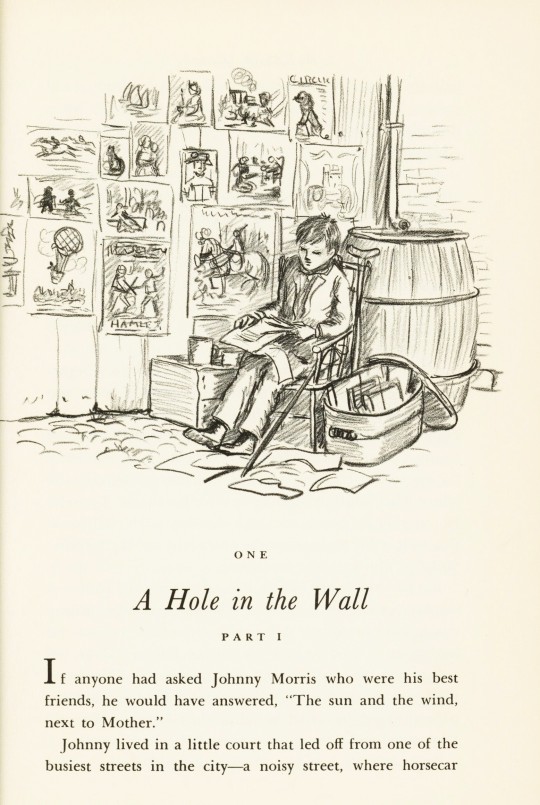

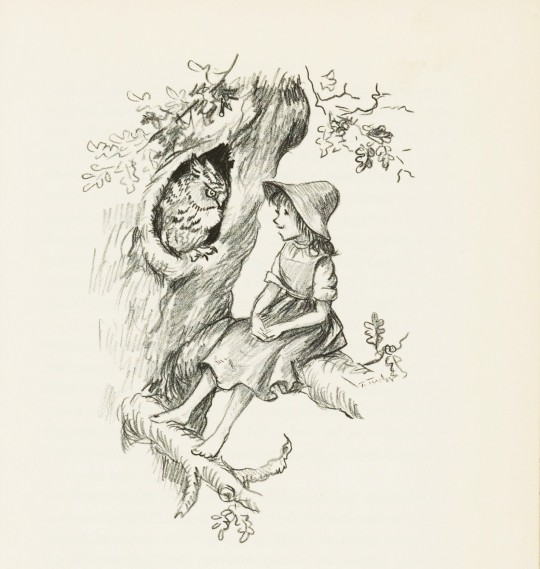

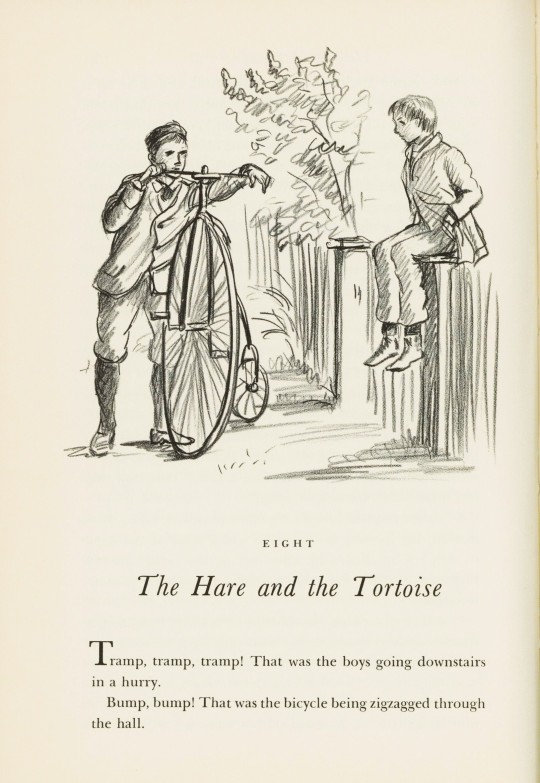
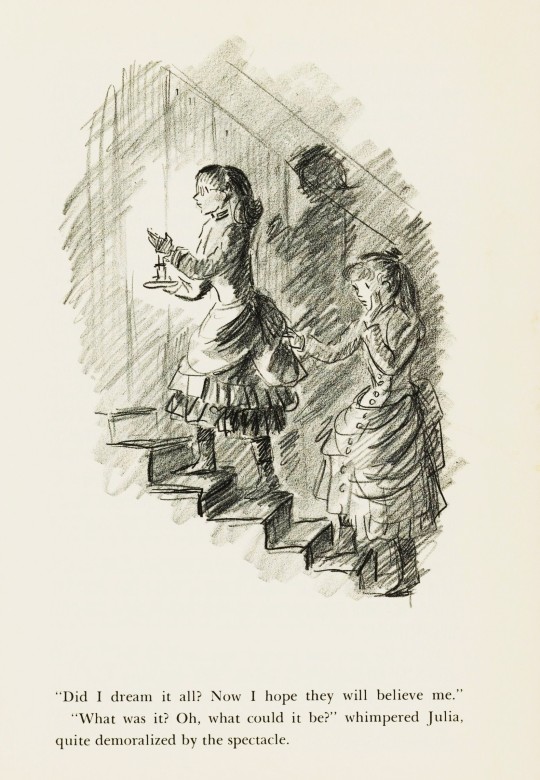


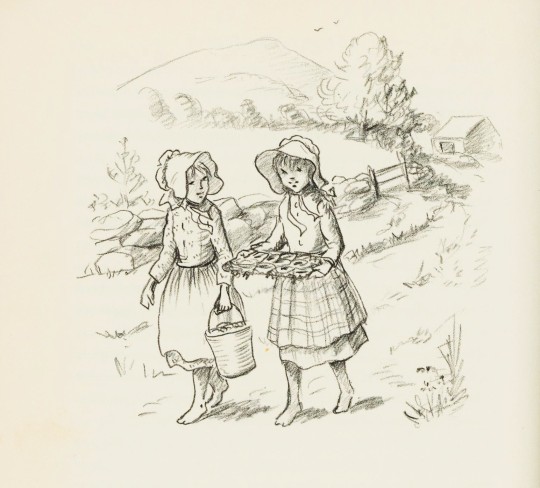
Milestone Monday
On this Milestone Monday, August 28, we’re celebrating the birthday of American illustrator Tasha Tudor (1915-2008). Tudor spent her life living in New England engrossed in nature and living a simplistic and self-reliant life consisting primarily of painting, husbandry, and weaving. In her 1937 engagement announcement she asserted her plan to “make illustration her life work” and within the year had been professionally published. In 1945, Tudor received a Caldecott Honor for her Mother Goose illustrations cementing her value and talent within the publishing world.
Among the nearly one hundred books Tudor illustrated, we are lucky to have four in our holdings, including A Round Dozen, stories by Louisa May Alcott, published in 1963 by The Viking Press, which includes a forward by children’s librarian and editor Anne Thaxter Eaton. Tudor’s drawings perfectly accompany Alcott’s stories of curious children, anthropomorphism, and delightful characters. Her figures, animals, and landscapes draw the reader in with their charming realism providing a unique visual experience that one can imagine echoes Tudor’s New England lifestyle.
View other Milestone Monday posts.
View more posts on children's books.
-- Jenna, Special Collections Graduated Intern
#milestone monday#milestones#birthdays#tasha tudor#a round dozen#louisa may alcott#anne thaxter eaton#illustrated books#Viking Press#children's books#Historical Curriculum Collection
32 notes
·
View notes
Photo
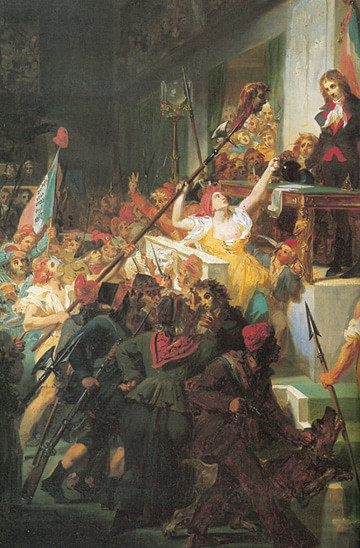
Thermidorian Reaction
The Thermidorian Reaction refers to the period of the French Revolution (1789-1799) between the fall of Maximilien Robespierre on 27-28 July 1794 and the establishment of the French Directory on 2 November 1795. The Thermidorians abandoned radical Jacobin policies in favor of conservative ones, seeking the restoration of a stable constitutional government and economic liberalism.
The Thermidorians came to power by conspiring against and overthrowing Maximilien Robespierre (1758-1794). After his execution, the Thermidorian regime set about dismantling the Reign of Terror by purging the Jacobins from positions of power and by violently suppressing their ideology in the First White Terror. Their efforts to return stability to France resulted in pursuance of conservative policies reminiscent of earlier phases of the Revolution; they restored freedom of religion, reintroduced free market capitalism, and allowed the return of some aristocratic émigrés into France, leading to a rise in openly royalist sentiment. These policies were met with mixed success.
The new regime was generally unpopular with the French people, who faced increased rates of poverty and starvation during the 15 months of Thermidorian rule. This led to multiple attempted coups, the most significant of which was the Uprising of 1 Prairial Year III (20 May 1795), in which insurgents demanded bread and the adoption of the dormant constitution of 1793, which had been written by the Jacobins. After the uprising had petered out, the Thermidorians wrote their own constitution of Year III (1795), which established the French National Directory.
Thermidorians
The name 'Thermidorians', ascribed to the conspirators against the Robespierrist regime, is derived from the mid-summer month of Thermidor in the French Republican calendar, during which the coup took place. Though possessing a shared distaste for Robespierre, the Thermidorians had little else in common. Some of them had been willing and enthusiastic participants of the Terror before they had run afoul of Robespierre and needed to be rid of him to save their own skins. Others had detested the Terror from the start and had been eager to bring it down. Many were conservative republicans who represented the centrist mass of Convention deputies known as the 'Plain', who desired to turn back the clock to the way the Revolution had been in 1792, pre-Terror; others wished to go back further, seeking a second attempt at constitutional monarchy, as in 1791.
This lack of consensus, as well as the absence of dominating personalities to rally behind, contributed to the ineffectiveness and unpopularity of the Thermidorian Convention. The lackluster success of their policies has certainly marred the Thermidorians' legacy. Their detractors viewed them as an unremarkable interlude between Robespierre and Napoleon at best; at worst, they were the gravediggers of their own Revolution, one-time revolutionaries seduced and corrupted by the heights of power. This latter context was used by Leon Trotsky in his 1937 book The Revolution Betrayed, in which he refers to the rise of Joseph Stalin as a Soviet Thermidor.
While there may be elements of truth to these claims, historian Bronisław Baczko asserts that the Thermidorians were merely being realistic. The Revolution, having lost much of its momentum, grew closer to succumbing to fatigue with every month. It was becoming clearer that the Revolution could no longer live up to the promises made in 1789. Therefore, rather than willfully burying the Revolution, Baczko argues that the Thermidorians realized these limitations and simply did their best to work around them. After the violence of the Terror, many French people desired stability over revolutionary progress, which the Thermidorians attempted to give them. In either case, the period of the Thermidorian Reaction marked a counter-revolution of sorts, moving away from the radical progress of the Jacobins and back toward stable conservatism.
Continue reading...
19 notes
·
View notes
Text
Wikipedia Featured Article Poll, Biographies Edition. Summaries and links below the cut
Margaret Ives Abbott (June 15, 1878 – June 10, 1955) was an American amateur golfer. She was the first American woman to win an Olympic event: the women's golf tournament at the 1900 Summer Olympics.
Lilias Eveline Armstrong (29 September 1882 – 9 December 1937) was an English phonetician. She worked at University College London, where she attained the rank of reader. Armstrong is most known for her work on English intonation as well as the phonetics and tone of Somali and Kikuyu. Her book on English intonation, written with Ida C. Ward, was in print for 50 years. Armstrong also provided some of the first detailed descriptions of tone in Somali and Kikuyu.
Morris Berg (March 2, 1902 – May 29, 1972) was an American catcher and coach in Major League Baseball, who later served as a spy for the Office of Strategic Services during World War II. Although he played 15 seasons in the major leagues, almost entirely for four American League teams, Berg was never more than an average player and was better known for being "the brainiest guy in baseball." Casey Stengel once described Berg as "the strangest man ever to play baseball".
Edward Dando (c. 1803 – 28 August 1832) was a thief who came to public notice in Britain because of his unusual habit of overeating at food stalls and inns, and then revealing that he had no money to pay. Although the fare he consumed was varied, he was particularly fond of oysters, having once eaten 25 dozen of them with a loaf and a half of bread with butter.
Harold Francis Davidson (14 July 1875 – 30 July 1937), generally known as the Rector of Stiffkey, was a Church of England priest who in 1932, after a public scandal, was convicted of immorality by a church court and defrocked. Davidson strongly protested his innocence and to raise funds for his reinstatement campaign he exhibited himself in a barrel on the Blackpool seafront. He performed in other sideshows of a similar nature, and died after being attacked by a lion in whose cage he was appearing in a seaside spectacular.
Marjory Stoneman Douglas (April 7, 1890 – May 14, 1998) was an American journalist, author, women's suffrage advocate, and conservationist known for her staunch defense of the Everglades against efforts to drain it and reclaim land for development. Moving to Miami as a young woman to work for The Miami Herald, she became a freelance writer, producing over one hundred short stories that were published in popular magazines. Her most influential work was the book The Everglades: River of Grass (1947), which redefined the popular conception of the Everglades as a treasured river instead of a worthless swamp. Its impact has been compared to that of Rachel Carson's influential book Silent Spring (1962). Her books, stories, and journalism career brought her influence in Miami, enabling her to advance her causes.
George Went Hensley (May 2, 1881 – July 25, 1955) was an American Pentecostal minister best known for popularizing the practice of snake handling. A native of rural Appalachia, Hensley experienced a religious conversion around 1910: on the basis of his interpretation of scripture, he came to believe that the New Testament commanded all Christians to handle venomous snakes.
Margaret Alice Murray FSA Scot FRAI (13 July 1863 – 13 November 1963) was a British-Indian Egyptologist, archaeologist, anthropologist, historian, and folklorist who was born in India. The first woman to be appointed as a lecturer in archaeology in the United Kingdom, she worked at University College London (UCL) from 1898 to 1935. She served as president of the Folklore Society from 1953 to 1955, and published widely over the course of her career.
Dom Pedro Afonso (19 July 1848 – 10 January 1850) was the Prince Imperial and heir apparent to the throne of the Empire of Brazil. Born at the Palace of São Cristóvão in Rio de Janeiro, he was the second son and youngest child of Emperor Dom Pedro II and Dona Teresa Cristina of the Two Sicilies, and thus a member of the Brazilian branch of the House of Braganza. Pedro Afonso was seen as vital to the future viability of the monarchy, which had been put in jeopardy by the death of his older brother Dom Afonso almost three years earlier.
Elias Abraham Rosenberg (Hebrew: אליאס אברהם רוזנברג; Hawaiian: Eliaka Apelahama Loselabeka; c. 1810 – July 10, 1887) was a Jewish immigrant to the United States who, despite a questionable past, became a trusted friend and adviser of King Kalākaua of Hawaii. Regarded as eccentric, he lived in San Francisco in the 1880s and worked as a peddler selling illegal lottery tickets. In 1886, he traveled to Hawaii and performed as a fortune-teller. He came to Kalākaua's attention, and endeared himself to the king with favorable predictions about the future of Hawaii. Rosenberg received royal appointments to several positions: kahuna-kilokilo (royal soothsayer), customs appraiser, and guard. He was given lavish gifts by the king, but was mistrusted by other royal advisers and satirized in the Hawaiian press.
#i expanded the summaries from the first sentence of the article to the first paragraph#cause with some of these people you don't get the full effect from just the first sentence#and also cause it's my poll.#Wikipedia polls
22 notes
·
View notes
Text
The Stolen Identity of Joseph Newton Chandler III

October 28, 2024
Robert Ivan Nichols, who went by the alias Joseph Newton Chandler III was born on September 12, 1926 in New Albany, Indiana.
On July 23, 2002, Robert Ivan Nichols committed suicide by a gunshot wound to the head in Eastlake, Ohio at the age of 75. After his death, investigators tried to locate his family and friends but to no avail. It was later found that Robert had been using the name Joseph Newton Chandler III for decades as a false identity, and that the real Joseph was an 8 year old boy who died in a car crash in 1945.
The real Joseph Newton Chandler III was born on March 11, 1937 in Buffalo, New York. On December 21, 1945, Joseph, his father Joseph Newton Chandler Jr., and his mother, Billie, were killed instantly in a car accident close by to Sherman, Texas.
The Chandler family had been on their way to see the boy's grandmother in Weatherford, Texas for the holidays. Their car had been in a head on collision with a truck driven by a man named L.C. Black of De Queen, Arkansas who left the scene uninjured.
Robert Nicholas joined the US Navy in World War II and served as a firefighter on the USS Aaron Ward which ended up being bombed by the Japanese in May 1945 off Okinawa. Robert was wounded in the back and hip and awarded the Purple Heart. He burned his uniforms after the war.
Robert married a woman named Laverne Kort in 1947. They had three sons and Robert worked as a draftsman for an electric company. In 1964, he left his wife and family and filed for divorce.
He moved to Dearborn, Michigan, where he told his parents he worked in the automobile industry. By March 1965, he wrote to his parents that he was now living in Richmond, California, while also sending a letter to his son Phil from Napa, California.
After this, Robert's family never heard from him again and later reported in missing in the same year. The family hired detectives to try to find Robert in both California and Indiana, but were unable to find any trace of him or anyone who knew him in those areas.
It is noted that Robert used his real name to work until around 1976.
Robert stole Joseph's identity in September 1978 in Rapid City, South Dakota, after applying for a social security card. He then moved to Cleveland, and worked a number of jobs. Robert had eventually become laid off in 1997.
It was also said that he claimed to have a sister named Mary Wilson, who lived in Columbus, Ohio, however the address he provided for her was made up and did not exist there. It was revealed later that Robert had used that address that he was born at in New Albany.
It was reported that Robert living under Joseph's identity, was a hermit who only left his house to work and eat. His co-workers reported that he rarely spoke to anyone and had no friends.
He also engaged in strange behaviour such as listening to white noise for hours, and one time drove 700 miles to an L.L. Bean store in Maine, only to leave when he got there because there was no spots available to park.
In 1992, he dressed up as a gangster and went to a Halloween party however the people there claimed he never spoke to anyone the entire night.
In 1989, Robert showed up to a local hospital with lacerations on his penis, claiming he got them from a vacuum. He also made homemade electronic devices a lot. He had a computer he used sometimes, and investigators found searches such as "Nazism" and "plastic explosives."
Robert's body was discovered in his apartment on July 30, 2002, about a week after he died. He shot himself in the mouth with a revolver he had purchased months before. On his calendar he had marked down the days until his suicide, and before doing it had closed his blinds and turned off his air conditioning. He had recently been diagnosed with colon cancer which may have been part or his reasoning for his death.
He had $82,000 in his bank account and had listed co-workers as his emergency contacts. Police could not find any of his relatives and that is what led them to realize he was living under a false name and identity. Authorities could not use fingerprints to assist in identification but were able to get a DNA sample from a hospital Robert had visited in 2000.
So why had Robert been living under the false identity of Joseph Newton Chandler III who had died almost 60 years prior and what was his real name?
Authorities speculated that Robert was a fugitive of some kind, either on the run after committing violent crimes or hiding from something. No theories have ever been confirmed.
Internet sleuths suggest he may have been the unidentified Zodiac killer as he resembled police sketches and was known to live in California. Some believed he was a fugitive named Steven Campbell, who was wanted for attempted murder. Authorities also thought he may have been a German soldier or Nazi official from World War II who had fled to the US to escape prosecution for war crimes.
Robert's name was not identified until 2018, 16 years after he died. In 2014, the case was reopened, and using DNA extracted from a tissue sample from his hospital visit, a CODIS profile was created, but no hits were found.
In 2016, there was a match found that indicated his possible surname was either Nicholas or Nichols. In 2018, the DNA Doe Project identified him as Robert Ivan Nichols. A CODIS match with Phil Nichols, Robert's son, confirmed his identification.
The reason for why Robert Nicholas stole the identity of an 8 year old boy who died in 1945, and lived under the identity since 1978 remains a mystery.
#true crime#crime#unsolved mysteries#unsolved#murder#unsolved case#solved#mystery#stolen#identity#theft
6 notes
·
View notes